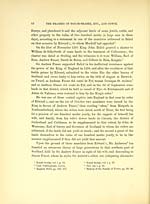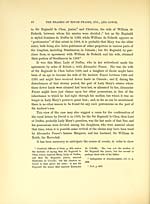Frasers of Philorth > Volume 1
(77)
Download files
Complete book:
Individual page:
Thumbnail gallery: Grid view | List view

THE FEASEES OF TOUCH-FEASEE, ETC., AND COWIE. 45
to the position of second son), and from him passing to another Simon, and
thence to one whom he calls the brother of this last Simon, Hugh, the
progenitor of the Frasers of Lovat ; but for these statements he adduces no
better authority than the apocryphal "Annals of the Frasers," published in
1 795 ; and the first of them, viz., that Simon was Sir Andrew's eldest son, will
be found completely refuted in the succeeding account of Alexander Fraser,
and also in the Appendix, in the account of that Simon Fraser ; but although
there is no record in these mandates, or elsewhere, of the name or family of
the lady who was Sir Andrew's wife, and had dower lands in Catania,
a fragment of information still extant, of which Mr. Anderson seems to
have been ignorant, affords some clue by which her family can be traced
with at all events greater probability than belongs to the theory advanced
by him.
This fragment of information is in the shape of a charter from David n.,
dated October 18th, 1363, 1 which recites royal letters granted by Piobert i.
on the 6th of November 1312, declaring that nothing in the agreements
ordered or arranged by the king between Lady Mary, widow of the late
Sir Eeginald le Chen, and Alexander Fraser, concerning the lands of Duffus,
should prejudice the status of inheritance of Lady Mary in those lands,
or in any way be construed into her disinheritance of them. And the
charter from David n. confirms the above royal letters in favour of Lady
Mary's heirs, giving them the same force and validity as they had during
his father's reign.
It is evident that Alexander Fraser, who was Sir Andrew Fraser's son,
had claims upon the property of the le Chen family in 1312 that were so far
legal and just as to be recognised by King Eobert, and made the subject of
agreement by his order ; and the necessity of the royal letters to protect the
hereditary rights of Lady Mary, npon that agreement being made, implies
that those claims were also of an hereditary nature.
Freskin de Moravia, dominus de Duffus, who flourished during the first
half of the thirteenth century, married Johanna, Lady of Strathnaver, in
Catania, 2 and, dying before 1269, left issue two coheiresses, Mary, married
1 Spalding Club, Antiquities of Aberdeenshire, vol. iv. p. 611.
2 Cart. Moray., preface, p. xxxiii.
to the position of second son), and from him passing to another Simon, and
thence to one whom he calls the brother of this last Simon, Hugh, the
progenitor of the Frasers of Lovat ; but for these statements he adduces no
better authority than the apocryphal "Annals of the Frasers," published in
1 795 ; and the first of them, viz., that Simon was Sir Andrew's eldest son, will
be found completely refuted in the succeeding account of Alexander Fraser,
and also in the Appendix, in the account of that Simon Fraser ; but although
there is no record in these mandates, or elsewhere, of the name or family of
the lady who was Sir Andrew's wife, and had dower lands in Catania,
a fragment of information still extant, of which Mr. Anderson seems to
have been ignorant, affords some clue by which her family can be traced
with at all events greater probability than belongs to the theory advanced
by him.
This fragment of information is in the shape of a charter from David n.,
dated October 18th, 1363, 1 which recites royal letters granted by Piobert i.
on the 6th of November 1312, declaring that nothing in the agreements
ordered or arranged by the king between Lady Mary, widow of the late
Sir Eeginald le Chen, and Alexander Fraser, concerning the lands of Duffus,
should prejudice the status of inheritance of Lady Mary in those lands,
or in any way be construed into her disinheritance of them. And the
charter from David n. confirms the above royal letters in favour of Lady
Mary's heirs, giving them the same force and validity as they had during
his father's reign.
It is evident that Alexander Fraser, who was Sir Andrew Fraser's son,
had claims upon the property of the le Chen family in 1312 that were so far
legal and just as to be recognised by King Eobert, and made the subject of
agreement by his order ; and the necessity of the royal letters to protect the
hereditary rights of Lady Mary, npon that agreement being made, implies
that those claims were also of an hereditary nature.
Freskin de Moravia, dominus de Duffus, who flourished during the first
half of the thirteenth century, married Johanna, Lady of Strathnaver, in
Catania, 2 and, dying before 1269, left issue two coheiresses, Mary, married
1 Spalding Club, Antiquities of Aberdeenshire, vol. iv. p. 611.
2 Cart. Moray., preface, p. xxxiii.
Set display mode to:
![]() Universal Viewer |
Universal Viewer | ![]() Mirador |
Large image | Transcription
Mirador |
Large image | Transcription
Images and transcriptions on this page, including medium image downloads, may be used under the Creative Commons Attribution 4.0 International Licence unless otherwise stated. ![]()
| Histories of Scottish families > Frasers of Philorth > Volume 1 > (77) |
|---|
| Permanent URL | https://digital.nls.uk/96566424 |
|---|
| Attribution and copyright: |
|
|---|
| Description | A selection of almost 400 printed items relating to the history of Scottish families, mostly dating from the 19th and early 20th centuries. Includes memoirs, genealogies and clan histories, with a few produced by emigrant families. The earliest family history goes back to AD 916. |
|---|

